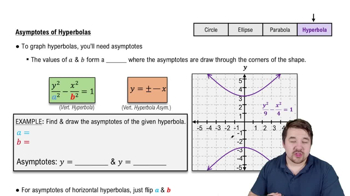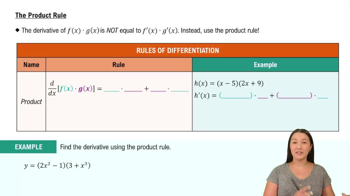Evaluate d/dx(x sec^−1 x) |x = 2 /√3.
Table of contents
- 0. Functions7h 54m
- Introduction to Functions16m
- Piecewise Functions10m
- Properties of Functions9m
- Common Functions1h 8m
- Transformations5m
- Combining Functions27m
- Exponent rules32m
- Exponential Functions28m
- Logarithmic Functions24m
- Properties of Logarithms36m
- Exponential & Logarithmic Equations35m
- Introduction to Trigonometric Functions38m
- Graphs of Trigonometric Functions44m
- Trigonometric Identities47m
- Inverse Trigonometric Functions48m
- 1. Limits and Continuity2h 2m
- 2. Intro to Derivatives1h 33m
- 3. Techniques of Differentiation3h 18m
- 4. Applications of Derivatives2h 38m
- 5. Graphical Applications of Derivatives6h 2m
- 6. Derivatives of Inverse, Exponential, & Logarithmic Functions2h 37m
- 7. Antiderivatives & Indefinite Integrals1h 26m
- 8. Definite Integrals4h 44m
- 9. Graphical Applications of Integrals2h 27m
- 10. Physics Applications of Integrals 3h 16m
- 11. Integrals of Inverse, Exponential, & Logarithmic Functions2h 34m
- 12. Techniques of Integration7h 41m
- 13. Intro to Differential Equations2h 55m
- 14. Sequences & Series5h 36m
- 15. Power Series2h 19m
- 16. Parametric Equations & Polar Coordinates7h 58m
6. Derivatives of Inverse, Exponential, & Logarithmic Functions
Derivatives of Inverse Trigonometric Functions
Problem 7.R.13
Textbook Question
10–19. Derivatives Find the derivatives of the following functions.
f(t) = cosh t sinh t
 Verified step by step guidance
Verified step by step guidance1
Recall the product rule for derivatives: if you have a function \(f(t) = u(t) v(t)\), then its derivative is \(f'(t) = u'(t) v(t) + u(t) v'(t)\).
Identify the two functions in the product: \(u(t) = \cosh t\) and \(v(t) = \sinh t\).
Find the derivatives of each function separately: \(\frac{d}{dt} \cosh t = \sinh t\) and \(\frac{d}{dt} \sinh t = \cosh t\).
Apply the product rule: \(f'(t) = (\sinh t)(\sinh t) + (\cosh t)(\cosh t)\).
Simplify the expression if possible, using hyperbolic identities such as \(\cosh^2 t - \sinh^2 t = 1\).
 Verified video answer for a similar problem:
Verified video answer for a similar problem:This video solution was recommended by our tutors as helpful for the problem above
Video duration:
3mPlay a video:
Was this helpful?
Key Concepts
Here are the essential concepts you must grasp in order to answer the question correctly.
Hyperbolic Functions
Hyperbolic functions, such as sinh(t) and cosh(t), are analogs of trigonometric functions but based on hyperbolas. They have unique properties and identities, like cosh²(t) - sinh²(t) = 1, which are useful in differentiation and integration.
Recommended video:

Asymptotes of Hyperbolas
Product Rule for Differentiation
The product rule states that the derivative of a product of two functions u(t) and v(t) is u'(t)v(t) + u(t)v'(t). This rule is essential when differentiating functions like f(t) = cosh(t) * sinh(t), where both factors depend on t.
Recommended video:

The Product Rule
Derivatives of Hyperbolic Functions
The derivatives of basic hyperbolic functions are: d/dt[sinh(t)] = cosh(t) and d/dt[cosh(t)] = sinh(t). Knowing these derivatives allows you to apply the product rule correctly to find the derivative of functions involving hyperbolic terms.
Recommended video:

Asymptotes of Hyperbolas

 7:26m
7:26mWatch next
Master Derivatives of Inverse Sine & Inverse Cosine with a bite sized video explanation from Patrick
Start learningRelated Videos
Related Practice
Textbook Question
77
views
